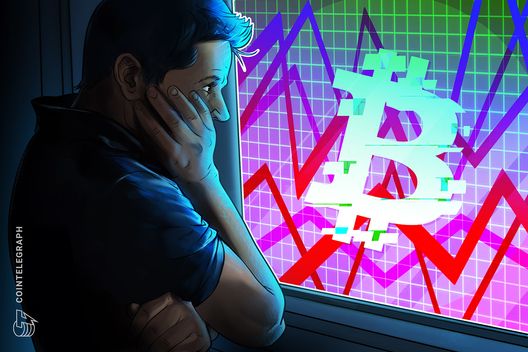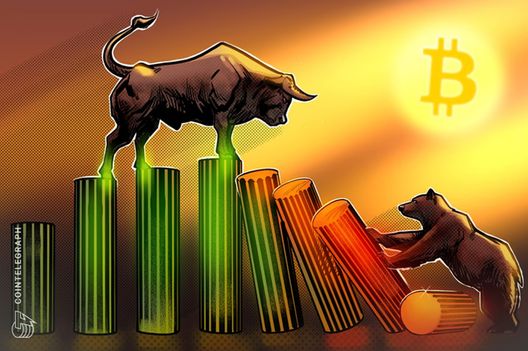
Jack Mallers ist überzeugt, dass Bitcoin auf eine drohende Bankenkrise hindeutet und eine derartige Entwicklung bereits berücksichtigt.

Finanzmittel Info + Krypto + Geld + Gold
Krypto minen, NFT minten, Gold schürfen und Geld drucken

Jack Mallers ist überzeugt, dass Bitcoin auf eine drohende Bankenkrise hindeutet und eine derartige Entwicklung bereits berücksichtigt.

Die Bitcoin-ETFs schwächeln nach dem jüngsten Abschwung von Bitcoin, doch das große Finanzinstitut Charles Schwab vermeldet dennoch hohes Interesse an der Anlageklasse.
The United States’ spot Bitcoin exchange-traded funds (ETFs) faced a challenging week, with over $1.2 billion in total outflows as Bitcoin prices tumbled.
Despite the decline in institutional inflows, Charles Schwab says investor engagement with crypto-related products is rising, reflecting a growing interest among retail and institutional clients in digital assets.
Data from SoSoValue shows that the eleven US-listed spot Bitcoin ETFs collectively recorded $366.6 million in outflows on Friday, closing out a negative week for both the products and the broader cryptocurrency market.
The largest withdrawal came from BlackRock’s iShares Bitcoin Trust (IBIT), which lost $268.6 million in a single day.
Fidelity’s Wise Origin Bitcoin Fund (FBTC) also saw substantial redemptions totaling $67.2 million, while Grayscale’s GBTC experienced $25 million in outflows. A smaller withdrawal was reported from the Valkyrie Bitcoin ETF, while the remaining funds saw no activity on Friday.
In total, spot Bitcoin ETFs in the US witnessed $1.22 billion in outflows over the past week, with only one day—Tuesday—showing minor inflows.
The downturn coincided with sharp declines in Bitcoin’s price, which fell from above $115,000 on Monday to just below $104,000 on Friday, marking a four-month low.
The steep decline highlights how sensitive institutional products remain to Bitcoin’s price movements, with ETF investors appearing to pull back amid growing market uncertainty.
While ETF redemptions signal cooling sentiment among some investors, Charles Schwab remains optimistic about the long-term potential of digital asset investment products.
Speaking on CNBC, CEO Rick Wurster revealed that Schwab’s clients now hold 20% of all crypto exchange-traded products (ETPs) in the US.
He added that interest in crypto has grown substantially over the past year, with visits to the company’s crypto-related webpages up 90%.
“Crypto ETPs have been very active,” Wurster said, emphasizing that the topic continues to draw high engagement from investors.
ETF analyst Nate Geraci noted that Schwab’s large brokerage platform positions it well to capture future demand.
The firm already offers crypto ETFs and Bitcoin futures and plans to launch spot crypto trading for clients in 2026, signaling a long-term commitment to the sector even amid short-term volatility.
October, historically one of Bitcoin’s strongest months, has so far delivered disappointing results.
Data from CoinGlass shows that Bitcoin has gained in ten of the past twelve Octobers, but this year, the asset is down 6% month-to-date.
Despite the slump, some market analysts remain hopeful that the trend of “Uptober” could return in the second half of the month.
Many point to the potential for Federal Reserve rate cuts later this year as a catalyst that could reignite demand for risk assets, including Bitcoin.
For now, however, the combination of ETF outflows, price pressure, and macroeconomic uncertainty has weighed heavily on crypto sentiment—leaving investors to watch whether the coming weeks can reverse October’s red start.
The post US Bitcoin ETFs see $1.2 Billion in weekly outflows appeared first on CoinJournal.
The cryptocurrency market has entered a phase of heightened anxiety as the Bitcoin Fear & Greed Index drops into the “extreme fear” territory.
Following a sharp decline in Bitcoin and other major digital assets, investor sentiment has deteriorated markedly, raising questions about whether a market bottom could be near—or if more downside lies ahead.
The Fear & Greed Index is designed to gauge investor sentiment in the Bitcoin and broader cryptocurrency markets.
It does so by aggregating data from multiple sources, including volatility, trading volume, market capitalization dominance, social media activity, and Google Trends.
The index operates on a scale of 0 to 100, with higher numbers indicating greed and lower numbers indicating fear.
Scores above 53 suggest traders are becoming greedy, while readings below 47 imply a fearful environment.
When the value falls under 25, it is considered “extreme fear,” and above 75, “extreme greed.”
As of now, the index stands at 22, firmly placing it in the extreme fear zone.
This marks a decline from recent readings that had shown only moderate fear, signaling that market sentiment has weakened significantly in a short period.
The latest move into extreme fear coincides with a steep decline in Bitcoin’s price.
The world’s largest cryptocurrency has fallen sharply over the past several days, losing about 13% over the last week to trade around $105,600 at the time of writing.
This downturn follows a broader sell-off across the crypto market, with other digital assets also posting significant losses.
The sentiment shift has been rapid—just last week, the index recorded a similar low of 24 after a sudden market drawdown.
That earlier episode saw the index swing dramatically from greed to extreme fear within a short span, reflecting how quickly optimism can turn to caution in the volatile crypto environment.
The market’s current position mirrors past instances when sharp price corrections triggered widespread fear among investors.
Historically, such periods of extreme sentiment have often corresponded with significant market turning points, although not always in a straightforward manner.
While a reading of extreme fear can appear alarming, it has sometimes preceded market bottoms in Bitcoin’s history.
The relationship between sentiment and price has typically been inverse—periods of extreme fear have often signaled potential accumulation phases, while extreme greed has tended to accompany market tops.
However, the connection is not guaranteed.
The last instance of extreme fear led to a temporary bottom before prices resumed their decline, suggesting that investor psychology alone may not determine near-term price direction.
As the market once again finds itself in a deeply fearful state, traders and analysts alike will be watching closely to see whether Bitcoin stabilizes or continues to fall.
The coming days could prove pivotal in determining whether this episode of fear marks the start of a longer bearish trend or the setup for another recovery phase.
The post Bitcoin market sentiment turns to extreme fear as BTC sinks to $105k appeared first on CoinJournal.

Der Bitcoin-Kurs befindet sich an einem Wendepunkt. Geht der Bullenmarkt weiter oder übernehmen die Bären? Darauf kommt es jetzt an: